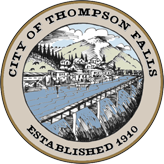Originally just Thompson, Thompson Falls was named in honor of fur trapper David Thompson, one of the best known explorers in the Northwest, the first person of European descent to enter many areas. A Canadian in the employ of the British North West Company, it was his job to establish trading posts for the purpose of obtaining furs for the company by trading with the natives. In 1809 he established
Saleesh House, the second trading post to be constructed in what is now Montana, about five miles east of here near the confluence of the Thompson and Clark Fork Rivers.

Though the railroad arrived in 1881 and a town site was platted in 1885, it was not until 1910 that the town of Thompson Falls was established. When gold was discovered in the nearby Cœur d'Alene area in 1883, Thompson Falls grew as a supply post, but it was the construction of the
Thompson Falls Dam, beginning in 1911, which supplied the town with a substantial economic base.
The seat of Sanders County, Thompson Falls has about 1,350 friendly residents. Rich in history, and preserving their local heritage, the city has many historic sites and buildings to explore. Stretching along the north side of the Clark Fork River, immediately opposite the Thompson Falls Dam and hydro station, Thompson Falls seems a somewhat sleepy little town content to bask in the natural beauty of the falls, the river and the mountains which surround it.
An interesting fact about Thompson Falls is its natural refrigeration. Crevices in the ground here emit air cooled by the earth to temperatures as low as 33° Fahrenheit. These currents were once used by businesses of the town to supply refrigeration. It's doubtful that this refrigeration method remains in use today.
When the writers of the American Guide Series book
Montana, A State Guide Book passed through they wrote the following entry, an interesting glimpse into the Thompson Falls of the 1930s.
THOMPSON FALLS, 65.7 m. (2,463 alt, 464 pop.), seat of Sanders County, was named for David Thompson. At first glance this seems to be merely a one-street town, a short line of buildings containing a service station, a hotel, and a few stores. Closer inspection reveals homes and more stores in a forest of yellow pine and brush. The streets have an atmosphere of privacy and peace enhanced by the view of wooded summits to the south and by the calmness of the Clark Fork, which at this point is a lake.
With the completion of the Northern Pacific Ry. in 1883, Thompson Falls and Belknap, 7 miles west, became rivals. The railroad company favored Belknap, and refused to stop trains here. The citizens of Thompson Falls thereupon placed huge logs on the railroad tracks, and, while crews were removing the obstructions, boarded the trains and persuaded emigrants to settle here. In 1883, 10,000 people on their way to the Idaho gold fields wintered in the place. Twenty saloons were operated, in tents and wooden shacks, and vigilantes worked overtime to maintain order. They once mailed notices to 25 desperadoes, ordering them to leave town; 24 left at once but the twenty-fifth went away only after feeling a noose about his neck. A few log cabins near the riverbank, with bullet riddled slab doors and window jambs, provide proof of the dangers of the period.
The town boasts of one of the natural marvels that are typical of so much of the northern mountain region. Crevices in the ground emit currents of air that range down to 33 F. This air has been piped and used for refrigeration since the first wells were dug 50 years ago.
The Clark Fork has been dammed at the natural falls (L) to produce 50,000 horsepower. The lake impounded for 2 miles behind the dam is the site of an annual regatta (3rd week of July). Trout fishing is good in the lake, in the river below the falls, and in Prospect Creek, a tributary that enters L.
From Montana, A State Guide Book, Page 336